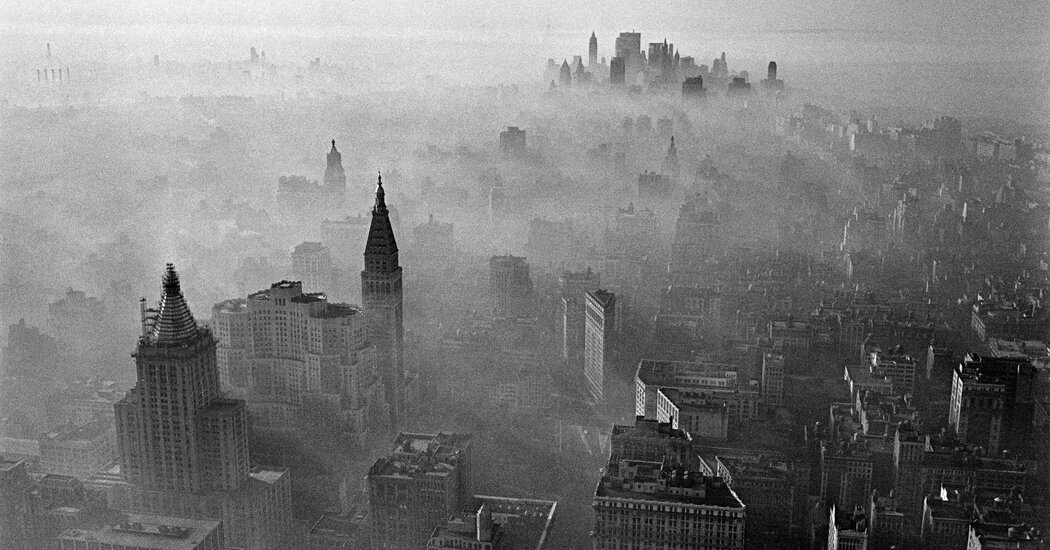In January 1912, in the depths of a New York City winter, an unusual new apartment complex opened on the Upper East Side.
The East River Homes were designed to help poor families fend off tuberculosis, a fearsome, airborne disease, by turning dark, airless tenements inside out. Passageways led from the street to capacious internal courtyards, where outdoor staircases wound their way up to each apartment. Floor-to-ceiling windows opened onto balconies where ailing residents could sleep. The rooftops drew tenants outside with covered porches and reclining seats, on which tuberculosis patients convalesced.
“It is believed that this type of dwelling will not only be an efficient aid in the actual treatment of cases of incipient tuberculosis, but an even greater benefit will be its influence as a measure of prevention,” wrote Dr. Henry Shively, who ran a tuberculosis clinic and developed the idea for the complex.
One of the paramount lessons of the Covid-19 pandemic is that fresh air matters. Although officials were initially reluctant to acknowledge that the coronavirus was airborne, it soon became clear that the virus spread easily through the air indoors. As the pandemic raged on, experts began urging building operators to crank up their ventilation systems and Americans to keep their windows open. The message: A well-ventilated building could be a bulwark against disease.
It was not a novel idea. More than a century ago, when infectious diseases ravaged cities in the United States and Europe, public health reformers preached the power of good ventilation, and open-air homes, hospitals and schools sprang up in New York, London and other locales on both sides of the Atlantic.
But over the last century, society lost hold of that idea. Scientific advances turned pathogens into problems that could be solved at the individual, biomedical level, with medicines and vaccines, rather than through infrastructure or societal change. Skylines became crowded with air-conditioned towers. An energy crisis encouraged engineers to seal structures tightly. And by the time the coronavirus arrived, Americans were spending their days in schools, offices and homes that could barely breathe.
“So you get a virus that spread nearly entirely indoors butting up against our building infrastructure that we know is not designed for health,” said Joseph Allen, an expert on healthy buildings at the T.H. Chan School of Public Health at Harvard.
Three years later, many Americans have a new, hard-earned appreciation for the health benefits of clean air. But some experts worry that the lesson may not stick. The Covid-19 public health emergency has now expired, and public attention has shifted to other airborne threats, such as the acrid wildfire smoke that has recently smothered many Eastern cities. Given these developments, it might be tempting to seal our buildings back up again.
That would be a mistake, experts say, especially in an era that is certain to bring more pandemics and air-quality crises. Being better prepared for the future, they say, will require us to avoid the missteps of the past.
“There’s a real history of forgetting, especially in the United States,” said Sara Jensen Carr, an architect at Northeastern University who studies the connection between design and health. “I think we’re on the verge of forgetting the importance of fresh air again.”
‘An abundant supply of fresh air’
In the 19th-century city, infectious diseases — tuberculosis, cholera, smallpox, yellow fever, typhoid — were an ever-present danger. Many aspects of the squalid urban environment, with its overflowing sewers and lack of clean drinking water, fueled these outbreaks. But poor ventilation was also to blame.
In New York City’s notorious tenements, many rooms lacked windows to the outdoors, and buildings were sometimes packed together so tightly that an open window provided little breeze. Conditions were especially dismal in cellar apartments. “Their foul, damp, sepulchral-like air being never visited by pure air and sunlight, they are fitter receptacles for the dead than the living,” the Association for Improving the Condition of the Poor wrote in an 1853 report.
Germ theory had not yet gained widespread acceptance; instead, the longstanding theory of miasma held that disease was the result of “bad air.” So sanitary reformers began calling for an overhaul of urban spaces, including improvements in ventilation. “An abundant supply of fresh air, at a proper temperature, is the first requisite of health in every place,” the Citizens’ Association of New York wrote in a report published in 1865.
New York undertook a variety of reforms, including restricting airless, underground apartments; requiring windows to the outdoors; and providing more space between buildings. Other cities and states developed new building codes and ventilation standards. “Ventilation comes next to godliness,” the president of the American Society of Heating and Ventilating Engineers declared in 1895, at the organization’s annual meeting.
(Reformers were not entirely virtuous in their motives. They were partly spurred on by a desire to quell social unrest, and the association of poor neighborhoods with disease and disorder also led to slum clearing.)
Similar reforms were also underway in hospitals thanks, in part, to the crusading work of Florence Nightingale, the British nurse who was stationed at a filthy military hospital during the Crimean War in 1854. The nurse, who believed in the healing power of “air from without,” helped popularize pavilion-style hospitals, which featured long, narrow wards with a row of large, open windows running along each wall.
“The entire building is designed around promoting the movement of fresh air,” said Annmarie Adams, an architectural historian at McGill University.
Outdoor air became part of the treatment regimen for tuberculosis, inspiring the design of sanitariums and fueling an open-air school movement that had students attending class on rooftops, in army tents and on ferries.
When the Spanish flu pandemic arrived in 1918, officials expanded the approach, said E. Thomas Ewing, a historian at Virginia Tech. Some conventional classrooms began operating with their windows open, temporary open-air hospitals appeared and newspapers advertised doctor-endorsed “winter window screens.”
In Chicago, sanitary inspectors checked the ventilation in churches. “Many clergymen substituted the subject of the epidemic for their regular texts and nearly all wove the healing powers of fresh air and sunshine into the theme of their regular sermons,” the department of public health noted in a 1919 report.
It is difficult to prove that better-ventilated buildings made a difference. Death rates — both overall and from certain diseases, such as tuberculosis — did drop after New York implemented sweeping sanitary reforms, although these gains cannot be attributed to ventilation alone.
But even as the fresh-air cure gained ground, other developments set the stage for its demise.
As science advanced, measures like hand-washing and chemical disinfection became key strategies for reducing the spread of pathogens, particularly in settings like operating rooms. For a time, this approach coexisted with the open-air strategy. “Some hospitals would have fresh air wards on one side,” said Jeanne Kisacky, an independent architectural historian, “and they’d have the closed wards for the surgical patients on another.”
But additional medical advances soon tipped the scales: Antibiotics and vaccines became highly effective ways to control infectious disease, making something as simple as an open window seem quaint.
“In schools and in hospitals, workplaces and homes, this desire for fresh air has been supplanted by just other priorities,” said Dr. Carr, the architect. “Chief among them: climate control.”
Air conditioning, invented in 1902, expanded rapidly after World War II. At the same time, the public began noticing that outdoor air was not always fresh; deadly, days-long smog events descended on cities and towns. By the middle of the 20th century, opinions on outdoor air had flipped.
“You go from Nightingale with, ‘It’s God’s gift to man, it’s natural, it’s healthy,’ to ‘It’s full of dust and dirt, and we don’t want it without it being filtered,’” Dr. Kisacky said.
The shift to comfort from health was also reflected in ventilation standards, which began to emphasize perceived indoor air quality by bringing in just enough outdoor air to ensure that buildings did not stink. Ventilation rates fell and then plummeted further during the energy crisis of the 1970s, when buildings were sealed even more tightly. “In fact,” said James Lo, an architectural engineer at Drexel University, “a lot of effort pre-Covid is to try to reduce the amount of ventilation because people don’t want to spend the energy.”
Minimum standards
In the United States today, the American Society of Heating, Refrigerating and Air-Conditioning Engineers, or ASHRAE, sets widely used indoor air quality standards and specifies minimum ventilation rates. In practice, these rates typically govern how buildings are designed, rather than how they are operated day to day, and many structures deliver less fresh air than they were designed to provide, experts said.
The standards define acceptable indoor air quality as air that does not have “harmful” levels of “known contaminants,” and with which at least 80 percent of occupants are satisfied. But infectious disease is not a focus.
“It says nothing about, ‘Does this level of air quality protect you from risk of infection when the seasonal flu is going around, or when there’s a novel epidemic disease, like Covid?’” said William Bahnfleth, an architectural engineer at Penn State University and the chairman of the epidemic task force at ASHRAE.
That is finally changing. ASHRAE is developing a new standard focused on reducing the transmission of airborne pathogens that applies both to new buildings and existing ones. It covers not only the rate of air exchange but also the use of filters and air cleaners, which can be highly effective ways to remove particles from the air. (Updated ventilation guidelines from the Centers for Disease Control and Prevention cover filters and air cleaners, too.)
Although the focus is on infectious disease, many of these same strategies should provide protection from wildfire smoke or other pollutants that may seep into buildings. But the new recommendations are unlikely to make a big difference unless they are incentivized or enforced in some way, Dr. Bahnfleth said. He noted that there is little government regulation of indoor air quality. Some government entity “needs to take some responsibility,” he said.
We have an opening to wage a new war on bad air, experts said, one that will be aided by tools and technologies that were not available to 19th-century sanitary reformers. But the key insight, and the animating spirit, is unchanged. “Our buildings,” said Dr. Allen, of Harvard, “should be seen as a public health tool.”




